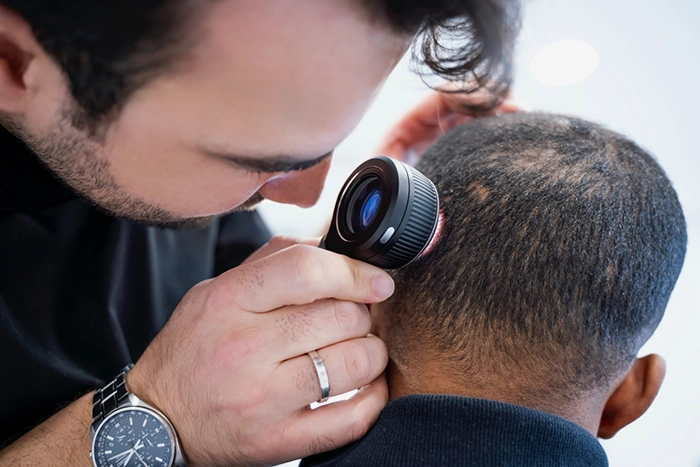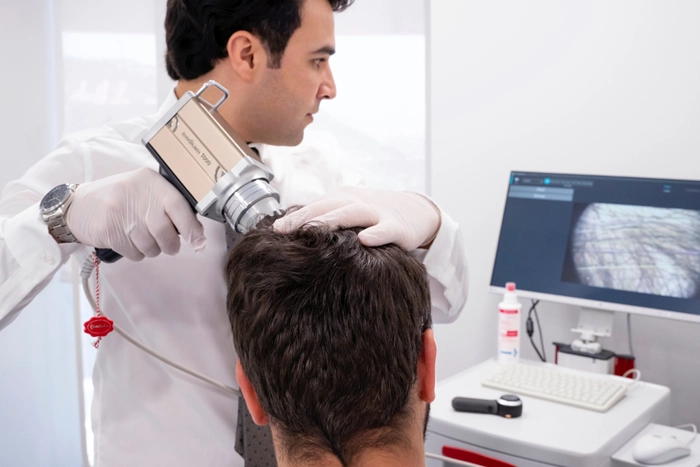
Hair loss can be caused by various factors such as genetics, hormonal changes, medical conditions and lifestyle. It can affect both men and women of all ages. Proper diagnosis of hair loss requires the expertise of a dermatologist who specializes in hair loss and scalp disorders. Based on the patient’s medical history, physical examination and blood tests, the cause of hair loss can be determined, and a suitable treatment can be recommended.
Welcome to the Civas Hair Loss Diagnostic Unit, where expertise meets innovation, and confidence is restored through comprehensive care. Your hair health journey is our top priority. We understand that hair is not just about looks; it's about overall health and confidence. With a team of seasoned experts specializing in the diagnosis, surgical, medical, and cosmetic aspects of hair diseases, we're committed to providing personalized and comprehensive care tailored to each patient.

One of our distinguishing features is the integration of latest technologies into the diagnostic process. By combining cutting-edge technology with traditional clinical and laboratory methods, we enhance the accuracy and efficiency of our hair disease diagnoses. This innovative approach allows us to provide tailored and effective treatment plans, ensuring optimal outcomes for our patients.
While many may perceive hair concerns as primarily cosmetic, at Civas Hair Transplant in Turkey, we recognize the profound psychological impact they can have on people. Our patient-centric approach acknowledges the importance of addressing both physical and mental well-being, ensuring a holistic and compassionate experience for every patient.
Trust Civas Hair Transplant to guide you on a path to enhanced well-being, empowering you to embrace life with renewed confidence and vitality.
Hair diseases constitute a complex group of conditions that can manifest due to various contributing factors. Hair loss is a condition impacting individuals of all ages, can lead to emotional distress, depression, and a significant blow to self-confidence. Navigating the intricacies of hair loss demands specialized expertise. For an accurate diagnosis and effective treatment, it is essential to undergo evaluation and examination by a dermatology specialist doctor. The evolving landscape of technology has ushered in new methods in the diagnosis of hair diseases, providing innovative hair loss treatments for those seeking optimal outcomes.
Understand hair health involves unraveling the common causes behind hair diseases and hair loss. The most common causes of hair diseases or permanent hair loss are:
In order to cure hair diseases and hair loss, achieving an accurate diagnosis is crucial. The journey toward understanding and treating these conditions begins with a comprehensive evaluation. The first step is gathering detailed information about the patient's medical history, lifestyle, and any significant events related to hair health. Next, a meticulous clinical examination of the scalp, hair follicles, and overall condition of the hair will be performed, providing valuable visual insights. Comprehensive blood tests are also required to assess factors such as hormonal levels, nutritional status, and any underlying medical conditions contributing to hair diseases.
Furthermore, a range of specialized methods and diagnostic tools are employed specifically for diagnosing hair loss.
As advancements in medical technology continue to unfold, the field of dermatology has embraced non-invasive methods as powerful tools for diagnosing various conditions, including hair loss in men and women. These innovative techniques offer a less intrusive yet highly effective means of understanding the intricacies of hair health.

Used in the diagnosis and ongoing monitoring of hair diseases through digital microscopy, this Fotofinder/Trichiovision system utilizes specialized software and a high-definition camera capable of achieving up to 70 times magnification and 1000 HD image quality. Optimized for precision, the system employs a meticulous process where a 1cm2 area with hair loss is shaved, dyed, and subjected to immediate macro and micro photography. Additional images are taken after 48-72 hours. Using image processing algorithms the system estimates hair count, hair density, single and cummulative hair thickness, velus and terminal hair percentages, number of follicullar units and anagen/telogen ratios. In complex situations that require further investigation, the results are shared with Tricholab Germany for further examination.
The daily hair loss estimation technique involves monitoring hair shedding on a daily basis, providing a continuous assessment of one's hair health. The average hair loss for a specific number of days is taken. It's crucial to note that an average daily hair loss of 100-150 strands is generally considered normal. Therefore, monitoring daily hair shedding becomes imperative, as it serves as a significant indicator for maintaining optimal hair health.
This meticulous process includes washing the hair for a specified duration and collecting it on a gauze cloth for precise counting based on individual strand lengths. The Standard Washing Test plays a crucial role in the differential diagnosis of genetic hair loss in women patients. Implementing this test aids in gaining valuable insights for optimizing hair health and forms an integral part of comprehensive diagnostic approaches in the field.
Another significant diagnostic method in the evaluation of hair health is the Pull Test. This test involves gently tugging on a cluster of hairs and observing the number of strands that detach. The standard criterion considers the loss of more than 10% of the pulled hairs as indicative of active hair shedding. This straightforward yet informative technique provides valuable insights into the hair growth cycle and helps identify potential issues such as telogen effluvium. The Pull Test serves as a practical tool in understanding hair health dynamics and contributes to the overall diagnostic arsenal for effective intervention.
The Trichogram, or Hair Pluck Test, is a specialized diagnostic procedure that involves the careful plucking and examination of 60-80 hair follicles under a microscope. This meticulous process allows for a close assessment of the stage in which the shed hairs are found, providing valuable insights into the dynamics of hair growth and shedding. By scrutinizing the individual follicles, the Trichogram aids in identifying potential issues such as hair loss patterns, follicular health, and the prevalence of specific hair growth phases.
Hair Check, a meticulous method for hair measurement, entails measuring a designated amount of hair in a specific area, enabling the identification of any decrease and facilitating the objective monitoring of improvement after treatment. Conducted at intervals of 3 months, Hair Check becomes an invaluable tool in tracking the objective changes in patients experiencing hair loss. Whether observing improvement or worsening, this systematic approach ensures a comprehensive understanding of the effectiveness of interventions and guides further steps in the management of hair health.
Dermatoscopic examination involves utilizing a dermatoscope to magnify and assess the intricate details of the hair and scalp. Particularly in digital dermatoscopes, the process is further enhanced as calculations are automatically conducted. By incorporating the examination of hair roots and scalp, dermatoscopy allows for precise insights into the health of the hair follicles and helps in identifying patterns associated with various hair disorders. This comprehensive diagnostic method not only ensures a thorough understanding of the patient’s hair health but also contributes to a more effective and tailored approach in managing hair loss concerns.
Utilizing the precision of an electron microscope for diagnosing hair loss proves to be invaluable for diagnosing structural abnormalities, diseases affecting the hair shaft, congenital hair disorders, and notably, fungal diseases. The electron microscope's high magnification capabilities allow for a meticulous examination that goes beyond what traditional microscopes can offer. This advanced approach enhances the diagnostic process, providing crucial insights into the underlying causes of hair loss, including fungal infections.
Phototricogram emerges as a valuable diagnostic tool employed to assess hair density, hair thickness, and hair growth dynamics. This non-invasive method involves capturing images of the scalp under controlled conditions, allowing for a detailed analysis of individual hair strands. By utilizing specialized software, phototricogram calculates essential parameters such as hair count, thickness, and growth rate, providing valuable insights into the overall health and vitality of the hair. This systematic approach aids in diagnosing various hair disorders, contributing to a comprehensive understanding of the factors influencing hair loss.
In certain cases, invasive methods become essential for a more in-depth understanding of hair loss. While invasive, these methods play a crucial role in uncovering precise information about the root causes of hair loss, guiding healthcare professionals towards tailored treatment plans.
Scalp biopsy is an an invaluable diagnostic method based on the pathological examination of a hair-bearing skin biopsy extracted from the affected area. This technique, often utilizing the punch biopsy method, provides detailed insights into hair disorders, making it one of the most beneficial approaches in diagnosis. Typically requiring a tissue sample with a 4-5 mm diameter, the obtained biopsy undergoes thorough examination both vertically and horizontally. To ensure a comprehensive analysis, the biopsy is carefully divided into two parts before submission. By using scalp biopsy, healthcare professionals gain precise information about underlying conditions affecting hair follicles, facilitating a targeted and informed approach in the diagnosis and management of hair loss.
Laboratory tests play a crucial role in decoding the complexities of hair loss by assessing the essential markers. Blood tests are instrumental in assessing complete blood count values, iron levels, hormonal balance, and the presence of crucial minerals and vitamins. Additionally, specialized evaluations are conducted through extensive autoantibody panels (ANA, ENA, etc.) to address specific conditions.
At Civas Hair Transplant, we prioritize the expertise of our two distinguished dermatologist doctors, Dr. Civas and Dr. Akpınar, both specializing in the treatment of hair diseases and hair loss. Before embarking on any treatment or hair transplant surgery, determining the root cause of the patient's hair loss is essential. This holds particularly true for conditions like cicatricial alopecia, where ensuring the disease is not active is crucial, as performing a hair transplant in cicatricial alopecia during an active phase may yield suboptimal results. Our approach is marked by the utilization of a diverse array of cutting-edge technologies to ensure our patients receive an accurate diagnosis and are deemed suitable candidates for hair transplant procedures. In cases where alternative treatments may be more appropriate, our expert doctors provide personalized recommendations.
For a comprehensive evaluation by our accomplished medical professionals, we encourage you to fill in the consultation form below, taking the first step towards a tailored and effective approach to addressing your unique hair concerns.